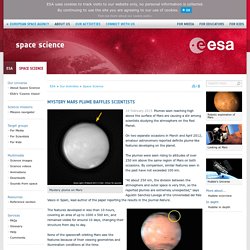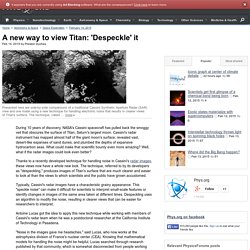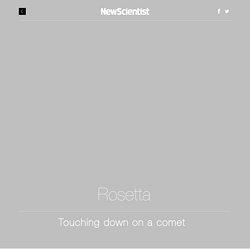

Space Exploration Day - 20th Jul, 2015. Errors & Missing Information If we've made a mistake or missed something important, please don't hesitate to contact us and set the record straight!

The origins of Space Exploration Day date back to man first walking on the moon, with the day itself first observed to commemorate this historic event during events held in the early 1970s. Houston Chronicle sur Twitter : "BREAKING: @SpaceX rocket blows up 3 minutes into launch. #SpaceX #hounews by @chronsciguy. SpaceX rocket blows up less than three minutes after launch - SciGuy. It’s been a long time, but SpaceX lost a cargo-carrying rocket today.

SpaceX launch web cast. Although it’s not clear what happened, the rocket blew up 2 minutes and 19 seconds into its launch this morning (see below). Elon Musk, the company’s founder, said the problem occurred shortly before the rocket’s first stage shut down. Later, he added, “There was an overpressure event in the upper stage liquid oxygen tank.” No humans were on board but the spacecraft was carrying 4,000 pounds worth of supplies to the International Space Station.
Critically, that’s the third cargo ship bound for NASA’s International Space Station with supplies lost in the last eight months: Orbital’s Antares rocket, Russia’s Progress spacecraft and now SpaceX’s Falcon 9 rocket. Beyond that SpaceX had planned to use the Falcon 9 rocket to carry an upgraded version of its Dragon spacecraft with astronauts aboard into space by 2017. All of that will now come into question for the company. BBC Breaking News sur Twitter : "Video shows moment #SpaceX rocket exploded over Florida. SpaceX explodes and disintegrates after launch - BBC News. Loreto Bello Gude sur Twitter : "Mystery Mars plume baffles scientists #science #space #Mars RT @OleNors. Mystery Mars plume baffles scientists. Mystery Mars plume baffles scientists Mystery plume on Mars 16 February 2015.

Maxime Duprez sur Twitter : "#Space: a new way to view #Saturn's satellite #Titan: 'despeckle' it! ► via @physorg_com. A new way to view Titan: 'Despeckle' it. During 10 years of discovery, NASA's Cassini spacecraft has pulled back the smoggy veil that obscures the surface of Titan, Saturn's largest moon.

Cassini's radar instrument has mapped almost half of the giant moon's surface; revealed vast, desert-like expanses of sand dunes; and plumbed the depths of expansive hydrocarbon seas. What could make that scientific bounty even more amazing? Well, what if the radar images could look even better? Thanks to a recently developed technique for handling noise in Cassini's radar images, these views now have a whole new look. The technique, referred to by its developers as "despeckling," produces images of Titan's surface that are much clearer and easier to look at than the views to which scientists and the public have grown accustomed.
Typically, Cassini's radar images have a characteristic grainy appearance. Maxime Duprez sur Twitter : "#Space: the amazing Whirlpool #Galaxy (M51) & its smaller companion NGC 5195 via @apod. 2009 May 26 - Whirlpool Galaxy Deep Field. Daniel Gennaoui sur Twitter : "A series of spectacular pictures from the greatest trip ever made. Find them here: #space.
Posts. Twitter. Rosetta. The final countdown: Days from the toughest space landing ever Ten years after leaving Earth, one of humanity's most ambitious space missions is ready for its climax – a nail-biting drop onto the surface of a comet MATT TAYLOR will soon experience the most agonising 28 minutes and 20 seconds of his life.

That's how long it takes a signal to travel the 500 million kilometres from the surface of comet 67P Churyumov-Gerasimenko to the European Space Agency's mission control in Darmstadt, Germany. So that's how long Taylor must wait to find out if his team has made history by landing a spacecraft on a comet for the very first time. The European Space Agency (ESA) craft, Rosetta, has been orbiting comet 67P since August.
Plenty could go wrong. There is a great deal we want to find out about 67P. Comets are often called dirty snowballs. The comets that remain today are the astronomical leftovers – the getaways. A better way is to visit a comet. Having tried a slap, it's time for a tickle. - Is there an end? by RMirandinha on deviantART. BiancaTeRito : Inside the #DragonV2 #SpaceX ... SpaceX : Meet #DragonV2, SpaceX's next ... Rosbiffrog : #SpaceX Inside Dragon Version ... Rosbiffrog : #SpaceX Inside Dragon Version ... Rosbiffrog : #SpaceX Inside Dragon Version ... MarcKBoucher : And landing #SpaceX Dragon ... Rosbiffrog : #SpaceX Dragon Version 2 is ... Maximaxoo : #Space: the stupendous variety...
How Many Moons Does Saturn Have? A collage of Saturn (bottom left) and some of its moons: Titan, Enceladus, Dione, Rhea and Helene.

Credit: NASA/JPL/Space Science Institute Saturn’s moons have such a variety of environments between them that you’d be forgiven for wanting to spend an entire mission just looking at its satellites. From the orangy, hazy Titan to the icy plumes emanating from Enceladus, studying Saturn’s system gives us plenty of things to think about. Not only that, the moon discoveries keep on coming. As of April 2014, there are 62 known satellites of Saturn (excluding its spectacular rings, of course).
Most of these moons are pretty small ones, just a few miles across, but on the other hand there are larger ones such as the moon Titan. All descriptions of the moons below are based on information from NASA. Live Soyuz TMA-12M Launch to Docking Coverage - Spaceflight101 Live. Ericarolfe : Today at ESRIN canteen its... Live From Space - Would space suit you? - Channel 4. VirtualAstro : Watching #SpaceLive over the... SpaceLive : The International Space Station... Jvreymondon : #INFOGRAPHIC: #SpacePlanes...
SpaceLive : We have lift off. #SpaceLive... SpaceLive : The ISS travels at 17,500 miles... SpaceLive : Life in space = no showers. SpaceLive : This helps to demonstrate the... Ice-capades: The true blue beauty of the icebergs of Iceland. By Sara Malm Published: 16:56 GMT, 12 November 2012 | Updated: 20:17 GMT, 12 November 2012 It has been called the nation of fire and ice and as these stunning pictures proves, it is certainly the latter.

The magnificent ever-changing landscapes of Iceland where the freezing temperatures make the icebergs and glaciers shift in every shade of blue, from turquoise and azure to indigo. With it's volcanic 'black beaches', northern lights and stunning fiords - home of the icebergs - the Northern European nation is a photographer's dream. Beyond the ice: Icebergs and snow covered mountains on the plains of Iceland are photographed through a hole in a wall of ice Fantastic icecapes: The coast of Iceland is everchanging with glaciers moving and icebergs freezing and melting each year as the seasons change Photographer Tim Vollmer, 41, and partner Marketa Kalvachova, 32, spend months travelling to the mythical island, and braving freezing temperatures to shoot the most amazing sights.
Spiral Galaxy Messier 83* Amazing Photos: Jupiter's Volcanic Moon Io. Astrophysics: Fire in the hole! Andy Potts In March 2012, Joseph Polchinski began to contemplate suicide — at least in mathematical form.

A string theorist at the Kavli Institute for Theoretical Physics in Santa Barbara, California, Polchinski was pondering what would happen to an astronaut who dived into a black hole. Obviously, he would die. But how? According to the then-accepted account, he wouldn’t feel anything special at first, even when his fall took him through the black hole’s event horizon: the invisible boundary beyond which nothing can escape.
But Polchinski’s calculations, carried out with two of his students — Ahmed Almheiri and James Sully — and fellow string theorist Donald Marolf at the University of California, Santa Barbara (UCSB), were telling a different story1. Free interview Zeeya Merali talks about what would happen if she fell into a black hole The team’s verdict, published in July 2012, shocked the physics community. Fiery origins Quantum mechanics says that information cannot be destroyed. Watch how America is getting frozen in this time-lapse from space.
TV. Sagan. Visible Structures by steve-burg on deviantART. Photo by redbullstratos. Home. SpaceRef - Space News and Reference. Space News. Space Images. Live_ISS_Stream on USTREAM: Live video from the International Space Station includes internal views when the crew is on-duty and Earth views at other times. Space and NASA News – Universe and Deep Space Information. The Sky Tonight - Astronomy News UK, Night Sky, Celestial Events, Images, Books and Star Naming Service. Northern Hemisphere Ian Morison tells us what we can see in the northern hemisphere night sky during September 2015.
